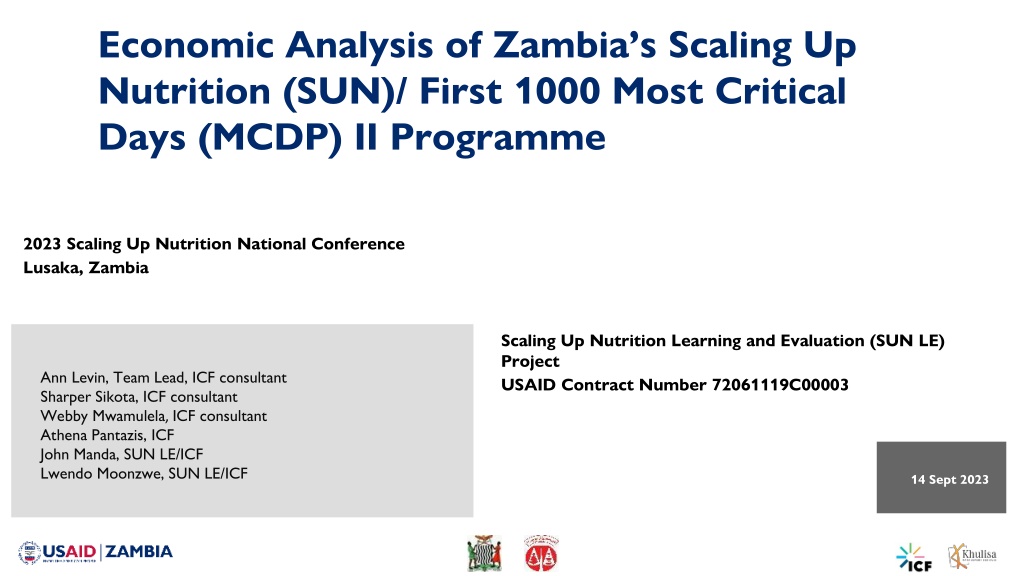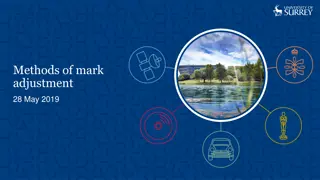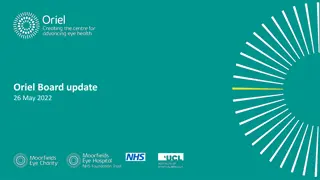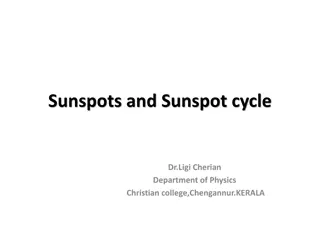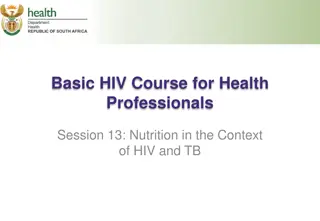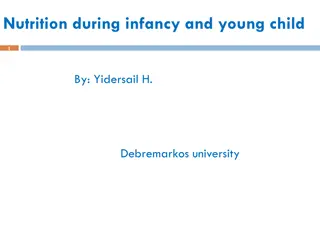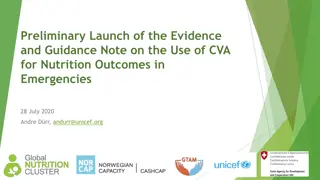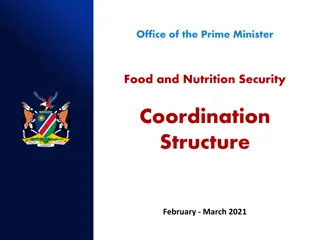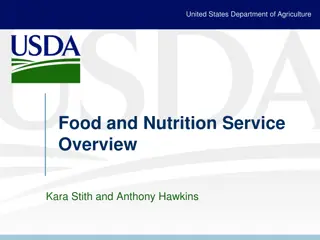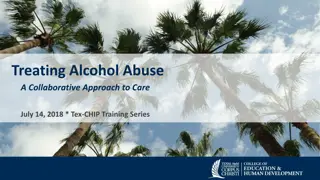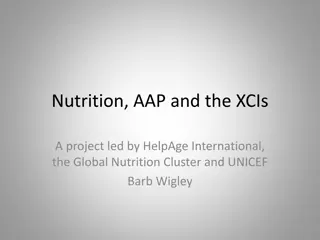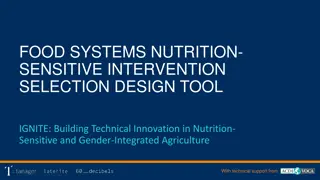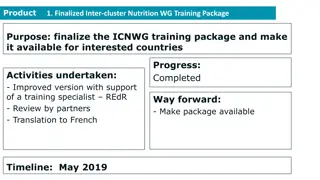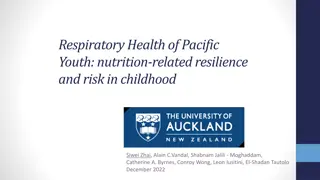Economic Analysis of Zambia's Scaling Up Nutrition (SUN) Programme
An economic analysis of Zambia's Scaling Up Nutrition (SUN) programme focusing on the First 1000 Most Critical Days (MCDP) II Programme in 2023. The analysis evaluates main drivers of stunting decline, impact assessment of interventions, and efficient resource allocation. It aims to provide insights on addressing child stunting due to chronic malnutrition in Zambia through effective resource utilization. The study explores data collection methods, findings, and recommendations for maximizing the programme's impact.
Download Presentation

Please find below an Image/Link to download the presentation.
The content on the website is provided AS IS for your information and personal use only. It may not be sold, licensed, or shared on other websites without obtaining consent from the author. Download presentation by click this link. If you encounter any issues during the download, it is possible that the publisher has removed the file from their server.
E N D
Presentation Transcript
Economic Analysis of Zambias Scaling Up Nutrition (SUN)/ First 1000 Most Critical Days (MCDP) II Programme 2023 Scaling Up Nutrition National Conference Lusaka, Zambia Scaling Up Nutrition Learning and Evaluation (SUN LE) Project USAID Contract Number 72061119C00003 Ann Levin, Team Lead, ICF consultant Sharper Sikota, ICF consultant Webby Mwamulela, ICF consultant Athena Pantazis, ICF John Manda, SUN LE/ICF Lwendo Moonzwe, SUN LE/ICF 14 Sept 2023
2 This presentation is made possible by the support of the American People through the United States Agency for International Development (USAID) and was prepared by the SUN LE Project. The authors views expressed in this publication do not necessarily reflect the views of USAID or the United States Government.
3 Agenda Introduction Data Collection Objective 1: Main Drivers of Stunting Analysis Background and Methods Final Results Objective 2: Impact Assessment Analysis Background and Methods Final Results Objective 3: Efficient Allocation of Resources Analysis Background and Methods Final Results Findings
5 Background Child stunting due to chronic malnutrition is a significant problem in Zambia because of inadequate nutrition-related practices and insufficient access to services. Resources for nutrition-related interventions are limited; therefore, the available budgets must be used in a manner that can achieve the greatest possible outcome. Economic analysis can show the GRZ and nutrition stakeholders whether: The stated nutrition outcomes are being met and provide information on efficient resource use. Their investments have achieved the intended outcomes. Interventions, packages of interventions and determinants are most effective for addressing stunting.
6 General Overview The three objectives of the study are as follows: 1. Identify and measure the main drivers of stunting decline in Zambia 2. Show the impact of SUN/MCDP II interventions and coverage on mortality and health burden 3. Assess efficient resource allocation decisions to maximise SUN/MCDP II impact
7 Types of Economic Analyses and Data Needs Approach/T ool Description of Data and Source Geographic Scope Economic Analysis Regression- decompositio n approach Objective 1: Evaluate the main drivers of stunting decline in Zambia Zambia DHS data for 2007 and 2018 from ZAMStat Zambia (national level) Programme data from implementing partners via MARF 30 SUN/MCDP II districts LiST and DALYs Objective 2: Assess impact of SUN/MCDP II interventions Programme data from government and implementing partners; Estimates on unit costs from investment case from World Bank Optima Nutrition and cost-benefit analysis Objective 3: Assess efficient resource allocation decisions to maximise SUN/MCDP II impact 30 SUN/MCDP I I districts
9 Data Collection Process Process The study team received approval letters from six Zambian Ministry Permanent Secretaries to release programme data for the study. Programme data were collected from some government ministries, SUN partners, and NGOs. Secondary data were collected from existing sources (i.e., Zambia DHS and DHIS2). Study challenges and resolution Limitation in data availability for 2019 and 2020 and not all districts had data for all indicators. Challenges around sharing expenditure data used alternative sources of data. Long turnaround time when engaged shifted timeline.
10 Summary Data Table Programme Data Received Cost Data Received # Stakeholder Name Details 1 2 3 4 5 6 GIZ UNICEF SUN TA Ministry of Health (MoH) Ministry of Agriculture Ministry of Fisheries and Livestock Yes Received Stakeholder data via MARF Received Received, complete Received, but relatively sparse Received, but relatively sparse No No No No No No MARF data Yes Yes MARF data MARF data 7 Ministry of Water and Sanitation MARF data Received, but relatively sparse No Ministry of Community Development and Social Services (MCDSS) World Vision FAO/WFP Provided limited programme data 8 Yes No 9 10 Yes Received Received, but relatively sparse No No MARF data Yellow received data but sparsely distributed; Red not expecting data; Green data received or expected imminently
11 Expenditure Data Used Unable to get expenditure data from government officers and implementing partners Instead used unit cost data of interventions from earlier studies with adjustment for inflation: 2016 World Bank nutrition investment case (used data from 2013 Zambia nutrition action plan) Also used cost data from other peer-reviewed studies on nutrition interventions If no other data, used default data from Optima Nutrition application Implication: Estimated programme costs are less accurate
Evaluate the Main Drivers of Stunting Decline in Zambia Objective 1
13 Decline in Stunting by Province, 2007 2018
14 Stage 1: Linear Regression Model Variables without a significant association with HAZ Variables retained for Stage 2 Variable Mother smokes Crop yield Child birth order Paternal occupation Bednet Owns agricultural land Number of children Breastfeeding Coefficient (SE) -.064 (.174) -.0005 (.000) .035 (.020) .048 (.032) .037 (.034) .074 (.042) .008 (.007) .005 (.0008) Variable Wealth Index Paternal education Diarrhoea in the past 2 weeks Maternal age Child's vaccination status Maternal literacy level Maternal height 4+ antenatal visits Basic sanitation Access to piped water Birth weight * p<.05, ** p<.01, *** p< .001 Coefficient (SE) .013 (.016)*** .111 (.029)*** -.115 (.021)*** .011 (.002)*** -.322 (.031)*** .128 (.035)*** .046 (.004)*** .019 (.035)** .187 (.045)*** .0125 (.015)** .0004 (.000) ***
15 Stage 2: Fixed Effect Model We selected only those variables that are statistically significant at the 5% level. We accounted for survey design and weights. We used selected variables to run a Fixed Effect Model to derive estimates of the marginal effects on HAZ over time. o To explain the relative contribution of each covariable over time to HAZ change, we used the Oaxaca-Blinder decomposition. o We used the estimated parameters from the Fixed Effect Model and the (weighted) means of explanatory variables in the two time points to obtain the predicted change in HAZ due to the change in each determinant. The product coefficients for individual determinants were subsequently ranked to identify the relative contribution of each factor to HAZ change.
16 Relative Contribution of Factors to Stunting Decline 28.7% 20.5% 14.5% 11.8% 9.6% 7.4% 7.3% 1.5% Access to piped water Maternal education Birth weight Basic sanitation Diarrhoea Maternal height Wealth index 4+ ANC visits
Impact of SUN/MCDP II on Mortality and Health Burden Objective 2
18 Evaluating Impact Using Lives Saved Tool (LiST) Used the Lives Saved Tool (LiST (spectrumweb.org)), Avenir Health LiST models the impact of interventions as the reduction of mortality and morbidity rates by the change in intervention coverage and the intervention's relative effectiveness Impact estimates are based on the coverage of 10 MCH indicators (WASH and health) covering services provided from 2019 to 2022. o WASH data were only available for 2021-22 from 13 SUN TA districts and 3 UNICEF districts To calculate impact for the programme, we follow the WHO CHOICE methodology for cost effectiveness analysis using LiST and compare intervention coverage to no programme coverage to estimate reductions in mortality and morbidity attributable to the programme. LiST provided district-level estimates of: Deaths prevented for children under 5 years Cases of stunting prevented in children under 5 years Cases of diarrhoea prevented in children under 5 years
19 Change in Estimated Under 5 Deaths (per 1,000) Attributable to Interventions, 2022 0 -5 Deaths per 1000 Chidren under 5 -10 -11 -13 -13 -14 -15 -15 -16 -16 -16 -17 -17 -18 -18 -18 -18 -19 -19 -19 -20 -19 -19 -20 -20 -20 -20 -21 -21 -23 -24 -25 -24 -24 -26 -30
20 Contribution by Intervention to Reduction in Child Mortality, 2019 2022 63% 17% 8% 6% 3% 1% 1% 0.5% Vitamin A supplementation Breastfeeding promotion Zinc for treatment of diarrhea MAM SAM Basic sanitation Point-of-use filtered water Hand washing with soap
21 Change in Estimated Stunting Prevalence (< 24 Months) Attributable to Interventions, 2022 0.0 -0.1 -0.2 -0.2 -0.3 -0.3 -0.3 -0.4 -0.5 -0.5 -0.6 Stunting Cases per 100 Children Under 5 -0.6 -0.7 -0.7 -0.7 -0.7 -0.8 -0.8 -1.0 -1.0 -1.2 -1.2 -1.5 -1.4 -1.4 -1.5 -1.5 -1.7 -1.9 -2.0 -2.0 -2.1 -2.2 -2.5 -2.5 -2.6 -3.0
22 Change in Estimated Diarrhoea Cases (< 5 Years) per Child-year (Incidence) Attributable to Interventions by District, 2022 0.0 -0.1 -0.1 -0.5 -0.4 -0.4 -0.5 -0.6 -0.8 -1.0 -0.9 Cases of Diarrhoea per Child-Year -1.3 -1.5 -1.4 -1.9 -1.9 -2.0 -1.9 -1.9 -2.0 -2.0 -2.0 -2.1 -2.2 -2.3 -2.3 -2.4 -2.5 -2.5 -2.5 -2.7 -2.7 -2.7 -2.8 -3.0 -3.1 -3.5 -3.5 -4.0
23 Contribution by Intervention to Reduction in Diarrhoea cases, 2019 2022 89% 5% 4% 1% 1% Vitamin A supplementation Basic sanitation Breastfeeding promotion Hand washing with soap Clean drinking water
24 Computing DALYs Based on LiST DALYs are a measure of both morbidity and mortality due to a disease. DALYs measure the years of life lost and years of healthy life lost to disability to illness such as stunting. To apply this method, used data from two sources: LiST analyses (projected mortality and morbidity averted due to programme) Institute Health Metrics and Evaluation Global Burden of Disease data Using these data, DALYs were calculated: The number of child deaths were multiplied by life expectancy in Zambia to get years of life lost. The number of diarrhoea and stunting cases were multiplied by disability weights and duration of disease to get years of health life lost to disability.
25 Disability Adjusted Life Years for Children Under 5 Years Averted in 30 Districts due to SUN/MCDP II by Year
Assess Efficient Resource Allocation Decisions Objective 3
27 Optima Nutrition Tool Combines an epidemiological model, cost functions, objective function defined by national strategic targets and constraints, and a mathematical optimization algorithm to estimate optimal budgets for nutrition Objective function is to reduce the number of stunted children at age 5 Prioritizes funding of interventions that affect stunting Analyses interventions over period 2018 2030 Relationship to Objectives 1 and 2: Uses same inputs and results as found in LiST analyses Focuses on interventions identified in OB analysis and adds some that have been shown to reduce stunting
28 Optima Nutrition Data Requirements Requires data on: Demographics: population size, fertility, mortality, morbidity, causes of death, breastfeeding prevalence Nutrition status: % of children that are stunted, wasted, and anaemic Programmatic characteristics: nutrition programme characteristics, intervention cost and coverage o Could not access expenditure costs of programme costs, so used unit cost data from Dayton et al. 2017, An Investment Framework for Nutrition in Zambia, World Bank Group
29 Nutrition Optima Interventions Available in Tool Infant and young child feeding education Lipid-based nutrition supplements Long-lasting bednets for malaria Micronutrient powders Multiple micronutrient supplementation ORS+/zinc Public provision of complementary foods Treatment of SAM Vitamin A supplementation WASH: five different interventions Zinc supplementation Balanced energy-protein supplementation (pregnant women) Calcium supplementation Cash transfers Delayed cord clamping Family planning Iron and folic acid fortification of staple foods Iron and folic acid supplementation IPTp for malaria Kangaroo mother care Existing Interventions Potential interventions to be added
30 Average Optimal Nutrition Budget Allocations needed to reduce stunting, 2018 2030 Stunting is projected to decrease from 5% for BL X 1 to 6% for BL X 1.5 from baseline when the budget allocations are optimized .
32 Main Findings 1. Identify and measure the main drivers of stunting decline in Zambia Access to piped water, maternal education, birth weight, and basic sanitation were shown to be the main contributors to stunting decline in Zambia. 2. Model impact of SUN/MCDP II interventions and coverage on mortality and health burden SUN/MCDP II intervention coverage is attributed with: o Average estimated reduction in under five mortality rates of 18.6 deaths per 1000 o Average estimated reduction in stunting prevalence among children <24 months of 1.1% 3. Assess efficient resource allocation to maximise SUN/MCDP II impact Introducing lipid-based nutritional supplements and complementary feeding and increasing Vitamin A and WASH intervention allocations will improve impact on stunting decline.
33 Considerations and Limitations Lack of nutrition sensitive interventions LiST and Optima Nutrition, specifically agriculture and dietary diversity Programme specific expenditure data was not available Gaps in program monitoring data Key indicators for analyzing drivers of stunting were not available in most recent Zambia Demographic and Health Surveys Change in child diversity measures between surveys Maternal height omitted in 2018
34 Works Cited Headey, Derek, John Hoddinott, and Seollee Park. "Accounting for nutritional changes in six success stories: a regression-decomposition approach." Global Food Security 13 (2017): 12- 20. Tasic, Hana, et al. "Drivers of stunting reduction in Ethiopia: a country case study." The American journal of clinical nutrition 112.Supplement_2 (2020): 875S-893S.
37 LiST Details LiST models the impact of interventions by reducing mortality rates (or morbidity rates) by the change in intervention coverage and the interventions relative effectiveness. Lives Saved = Cause-specific mortality X Coverage change X (Affected fraction X Effectiveness) LiST estimates maternal and child deaths and illness prevented based on the coverage of key indicators using assumptions about: Mortality rates and prevalence of key diseases, which are from country-level estimates from WHO, UNICEF, UNFPA, World Bank Group, the United Nations Population Division, and the United Nations Inter-agency Group for Child Mortality Estimation Effectiveness of interventions in preventing disease and death, which come from systematic reviews, meta-analyses, Delphi estimations, and randomized control trials based on the Child Health Epidemiology Reference Group (CHERG) guidelines
38 Regression Decomposition Model Fit R-squared: Within =3.65% Between=12.45% Overall: 4.67% Intraclass correlation (rho), shows how much of the variance in HAZ score is explained by the difference across time. In this case is 14.2%. The F-test to see whether all the coefficients in the model are jointly different than zero, Prob > 0.0000.
39 Stage 1: Linear Least Square Regression Model Outcome variable is height for age (HAZ) z-scores for children aged 0-59 months. We used the continuous formulation of HAZ (as opposed to categorical stunting) as the dependent outcome to strengthen statistical power of the analyses. We used regression models to assess the relationships between HAZ for child i at time t, (?????) with a vector of time-varying determinants (X), time-invariant child age and sex control variables (C), and a survey round time variable (T) to capture any trend effects. ????,?= ? ??,?+ ??+ ? + ??,? We selected only those variables that are statistically significant at the 5% level. We accounted for survey design and weights. Decomposed contribution of selected factors on the decline in stunting: Estimate the predicted change in HAZ from the earlier survey and then estimate the contribution of each variable to changes in HAZ.
